Install the app
How to install the app on iOS
Follow along with the video below to see how to install our site as a web app on your home screen.
Nota: This feature may not be available in some browsers.
Je gebruikt een verouderde webbrowser. Het kan mogelijk deze of andere websites niet correct weergeven.
Het is raadzaam om je webbrowser te upgraden of een alternatieve webbrowser te gebruiken.
Het is raadzaam om je webbrowser te upgraden of een alternatieve webbrowser te gebruiken.
Catfish club 20 racer bouwproject
- Topicstarter ragbak
- Startdatum
Harold
PH-SAM
.........Lamineren met lamineer epoxy met een paar gram eps50 om het epoxy te laten opschuimen tussen balsa, glas en styropor.....
Wat is eps50?
eps50 is een goedje wat je aan lamineer epoxy kunt toevoegen waardoor de epoxy gaat schuimen, en dus meer volume inneemt. Zo krijg je een betere hechting tussen indekking, glas en piepschuim. 1-2% toevoegen aan reeds gemengde epoxy. De potlife wordt hierdoor wel gehalveerd. Wel even doorwerken dus ...
Ha Wubbo, blij dat je er zo tegenaan kijkt 
Ambitie is er in ieder geval. En nee, van mij geen excuses!
--May the best man win--
Hoewel dit digitale uitdagen toch ook fun is haha, de messen worden geslepen... heb nu al zin in seizoen 2010 .
.
Vanavond maar even de vleugelaansturing gemaakt van verenstaal. De balllinks vastgesoldeerd (afgekeken van Martijn), dat is dus nul speling!
Nu nog in de vleugel en ailerons aanbrengen.
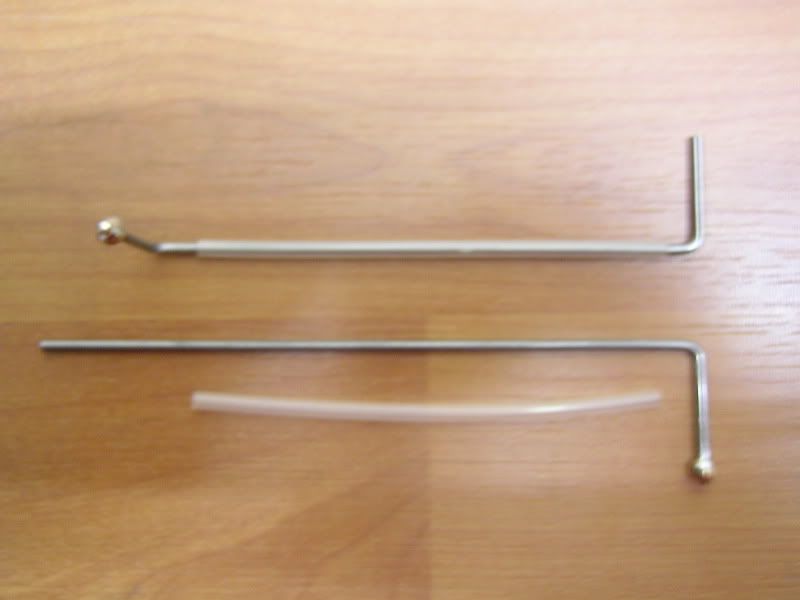

Maar goed ik ga dus vliegen met maar 1 aileron servo. De vraag is nu welke, beetje bladerend door het forum kom ik op Futaba S3101 of Hitec HS-81. HS-81 heeft blijkbaar niet zo'n goede reputatie(?) maar is wel weer metal geared en dat is de S3101 niet.
Iemand nog andere suggesties?
Ambitie is er in ieder geval. En nee, van mij geen excuses!
--May the best man win--
Hoewel dit digitale uitdagen toch ook fun is haha, de messen worden geslepen... heb nu al zin in seizoen 2010
Vanavond maar even de vleugelaansturing gemaakt van verenstaal. De balllinks vastgesoldeerd (afgekeken van Martijn), dat is dus nul speling!
Nu nog in de vleugel en ailerons aanbrengen.


Maar goed ik ga dus vliegen met maar 1 aileron servo. De vraag is nu welke, beetje bladerend door het forum kom ik op Futaba S3101 of Hitec HS-81. HS-81 heeft blijkbaar niet zo'n goede reputatie(?) maar is wel weer metal geared en dat is de S3101 niet.
Iemand nog andere suggesties?
M.l.v.Doesburg
PH-SAM
3102 is de futaba variant met metalen tandwielen! Ik gebruik in mijn club 20's de 3101 aangezien die de helft van de prijs zijn in verhouding met de metalen tandwieltjes.
Ik hebe r nog nooit eentje stuk gehad.
Ik hebe r nog nooit eentje stuk gehad.
3102 is de futaba variant met metalen tandwielen! Ik gebruik in mijn club 20's de 3101 aangezien die de helft van de prijs zijn in verhouding met de metalen tandwieltjes.
Ik hebe r nog nooit eentje stuk gehad.
Same here, ik gebruik de 3101's in mn quicky (overigens maar 1 op de ailerons). Werkt prima.
ik gebruik ook hs 81 servo's met kunsstof tandwielen voor mijn club 20, inderdaad snel kapot maar toch wel bruikbaar. hc heeft ook een goedkopere vervanger .
Het lijkt me verstandig dat ivm de veiligheid de HS81 niet meer gebruikt mag worden in pylonracers. Ik zal dit punt op de agenda zetten voor de pylon jaarvergadering op 17 januari.
Het lijkt me zinvol om deze servo's niet in te bouwen als de tandwielen erg snel stuk gaan. Zeker niet in nieuwe in te bouwen als je een beter alternatief hebt. Kost mischien een paar euro meer maar dan hoef je geen tandwiel setjes te kopen en servo's te wisselen op een wedstrijd. Kies voor een degelijke servo en niet voor de goedkoopste.
Even afgezien van de veiligheid gaat racen om betrouwbaarheid ! Om te winnen moet je wel eerst over de finish streep. En de kist heel aan de grond zetten voor de volgende race. Daarbij hoort een degelijke kist met degelijke servo's, opgeladen en goede accu's, goede ontvangers met voldoende reikwijdte, goede verbindingen enz. en een goede landing zonder brokken. Veel mensen vergeten dit laatste en prakken zo'n kist na de race maar ergens in het veld met weer een hoop herstel werk tussen de vluchten in.
Nu is de tijd om alles te checken voor komend seizoen. Check je accu's eens op je lader en bij twijfel. Klap met de hamer (leuk met een veiligheidsbril op) of knip het stekkertje eraf en de chemobak in. Niet terug in je voorraad stoppen over een jaar weetje niet meer waarom die daar lag en vlieg je als nog je kist nieuwe kist kapot. Een accu'tje kost een paar euro das veel minder dan een nieuwe kist bouwen. En bovendien heb je na die crash toch een nieuwe accu nodig ,en een ontvanger en een tank en een sproeiernaald en ...... enz., dus waarom wachten ????
Dit is het tech en safety gedeelte uit het F3D reglement en een voorstel voor in het Nederlandse reglement met een paar kleine aanpassingen.
Officer will not allow it to fly in the race.
Even afgezien van de veiligheid gaat racen om betrouwbaarheid ! Om te winnen moet je wel eerst over de finish streep. En de kist heel aan de grond zetten voor de volgende race. Daarbij hoort een degelijke kist met degelijke servo's, opgeladen en goede accu's, goede ontvangers met voldoende reikwijdte, goede verbindingen enz. en een goede landing zonder brokken. Veel mensen vergeten dit laatste en prakken zo'n kist na de race maar ergens in het veld met weer een hoop herstel werk tussen de vluchten in.
Nu is de tijd om alles te checken voor komend seizoen. Check je accu's eens op je lader en bij twijfel. Klap met de hamer (leuk met een veiligheidsbril op) of knip het stekkertje eraf en de chemobak in. Niet terug in je voorraad stoppen over een jaar weetje niet meer waarom die daar lag en vlieg je als nog je kist nieuwe kist kapot. Een accu'tje kost een paar euro das veel minder dan een nieuwe kist bouwen. En bovendien heb je na die crash toch een nieuwe accu nodig ,en een ontvanger en een tank en een sproeiernaald en ...... enz., dus waarom wachten ????
Dit is het tech en safety gedeelte uit het F3D reglement en een voorstel voor in het Nederlandse reglement met een paar kleine aanpassingen.
Technical checks and safety requirements
(a) At registration of the model aircraft, engines and exhaust systems before the competition, the
Technical Officer may carry out technical checks either at his own discretion or at the request of the
competitor to check if the models comply with the technical specifications. However, under all
circumstances during the competition, it is the competitor’s responsibility to ensure that entire model
aircraft complies with the technical specifications in 5.2.1–5.2.11.
(b) During the competition all measuring equipment will be at the disposal of competitors to check their
model aircraft if they wish to.
(c) After a race, the Technical Officer may take any model aircraft for inspection (ABR B 16.13). The
Technical Officer may ask the competitor to empty the tank for weight checking and for analysis of
the fuel. Where a fuel analysis is made, a sample of the contest fuel shall also be taken for
comparison. If, after analysis of the fuel from the tank, this fuel appears to be different from the
contest fuel, the competitor will be disqualified from the competition. If the fuel analysis result is not
Technical Officer may carry out technical checks either at his own discretion or at the request of the
competitor to check if the models comply with the technical specifications. However, under all
circumstances during the competition, it is the competitor’s responsibility to ensure that entire model
aircraft complies with the technical specifications in 5.2.1–5.2.11.
(b) During the competition all measuring equipment will be at the disposal of competitors to check their
model aircraft if they wish to.
(c) After a race, the Technical Officer may take any model aircraft for inspection (ABR B 16.13). The
Technical Officer may ask the competitor to empty the tank for weight checking and for analysis of
the fuel. Where a fuel analysis is made, a sample of the contest fuel shall also be taken for
comparison. If, after analysis of the fuel from the tank, this fuel appears to be different from the
contest fuel, the competitor will be disqualified from the competition. If the fuel analysis result is not
SC4_Vol_F3_Pylon_09 Effective 1st January 2009 Page 10
available during the competition then the disqualification may be applied retrospectively.
(d) If the model aircraft is not according to the technical specifications in 5.2.2– 5.2.11, the competitor
shall be disqualified from the competition.
(e) The Contest Director has the right to request any competitor to make a flight to demonstrate the
airworthiness of his model aircraft.
(f) Safety inspections of all aircraft before or during registration and at random as a pre-flight check
during the competition shall be conducted by the contestant under the supervision of the Technical
Officer.
The list of safety checks should include the following:
i) Push/pull rods or cables, control horns, and servo leads shall be installed in such a way that
they will not become disconnected in flight. Clevises shall be physically held closed by short
pieces of fuel tubing or similar material. Metal clevises shall be protected from deterioration
of the threads due to vibration by means of a lock nut, thread treatment such as Loctite
(d) If the model aircraft is not according to the technical specifications in 5.2.2– 5.2.11, the competitor
shall be disqualified from the competition.
(e) The Contest Director has the right to request any competitor to make a flight to demonstrate the
airworthiness of his model aircraft.
(f) Safety inspections of all aircraft before or during registration and at random as a pre-flight check
during the competition shall be conducted by the contestant under the supervision of the Technical
Officer.
The list of safety checks should include the following:
i) Push/pull rods or cables, control horns, and servo leads shall be installed in such a way that
they will not become disconnected in flight. Clevises shall be physically held closed by short
pieces of fuel tubing or similar material. Metal clevises shall be protected from deterioration
of the threads due to vibration by means of a lock nut, thread treatment such as Loctite
® or
Vibra-tite ®, or a similar method. Ball links shall be tight.
ii) All screws holding the engine to the mount and the mount to the firewall shall be in place and
secure.
iii) The radio receiver and battery pack shall be surrounded by soft foam rubber or other
vibration dampening material and adequately protected against contamination by engine
exhaust, raw fuel, or fuel residue.
iv) Batteries shall be of adequate capacity for the size and number of servos used. Minimum
battery capacity shall be: 500 milliamp-hours (mAh).
v) Servos controlling the pitch and roll functions shall be of adequate strength for the weight and
speed of the aircraft. Whenever a single servo is used to control one of these functions, it
shall be designed and built to accommodate at least four mounting screws. When two or
more servos are used together to control the same function, as in the case of dual aileron
servos or the movable tail surfaces on a "v" tailed aircraft, each of said servos may be of the
two-screw variety.
vi) Control surfaces shall be firm on the hinge line without excessive play. Safety officers shall
be alert to the danger of excessive play whenever electronic servo throw reduction is used in
combination with a mechanically inefficient linkage.
vii) All screws holding the servos to the servo rails or trays and holding any trays to the airframe
shall be in place and secure. Rubber grommets shall be used on all servos designed to
accept them. If the heads of the servo mounting screws are small enough to pull through the
grommets, washers shall be used to prevent this.
viii) Pushrods shall have only one threaded end that is free to turn. The other end shall consist of
a "Z" bend, an "l" bend with keeper or collar, a metal clevis that is soldered on, or a threaded
ball-link that is glued or otherwise secured so that it cannot turn.
ix) Wings, if removable, shall be securely attached to the fuselage with bolts or machine screws.
x) Wheels shall be securely attached and shall turn freely.
xi) The aircraft shall be free of stress cracks and any other indications of structural damage.
xii) Proper functioning of the engine shut-off by fail safe.
If a model aircraft does not comply with the safety items during a pre-flight check, the Technical
Vibra-tite ®, or a similar method. Ball links shall be tight.
ii) All screws holding the engine to the mount and the mount to the firewall shall be in place and
secure.
iii) The radio receiver and battery pack shall be surrounded by soft foam rubber or other
vibration dampening material and adequately protected against contamination by engine
exhaust, raw fuel, or fuel residue.
iv) Batteries shall be of adequate capacity for the size and number of servos used. Minimum
battery capacity shall be: 500 milliamp-hours (mAh).
v) Servos controlling the pitch and roll functions shall be of adequate strength for the weight and
speed of the aircraft. Whenever a single servo is used to control one of these functions, it
shall be designed and built to accommodate at least four mounting screws. When two or
more servos are used together to control the same function, as in the case of dual aileron
servos or the movable tail surfaces on a "v" tailed aircraft, each of said servos may be of the
two-screw variety.
vi) Control surfaces shall be firm on the hinge line without excessive play. Safety officers shall
be alert to the danger of excessive play whenever electronic servo throw reduction is used in
combination with a mechanically inefficient linkage.
vii) All screws holding the servos to the servo rails or trays and holding any trays to the airframe
shall be in place and secure. Rubber grommets shall be used on all servos designed to
accept them. If the heads of the servo mounting screws are small enough to pull through the
grommets, washers shall be used to prevent this.
viii) Pushrods shall have only one threaded end that is free to turn. The other end shall consist of
a "Z" bend, an "l" bend with keeper or collar, a metal clevis that is soldered on, or a threaded
ball-link that is glued or otherwise secured so that it cannot turn.
ix) Wings, if removable, shall be securely attached to the fuselage with bolts or machine screws.
x) Wheels shall be securely attached and shall turn freely.
xi) The aircraft shall be free of stress cracks and any other indications of structural damage.
xii) Proper functioning of the engine shut-off by fail safe.
If a model aircraft does not comply with the safety items during a pre-flight check, the Technical
Officer will not allow it to fly in the race.
Nu zijn dat natuurlijk regels voor F3D modellen, waarbij de krachten wel een stuk extremer zijn dan bij een willekeurige club-20 of quickie(NL).
Maar ik ben het wel met de strekking van het stuk eens.
Een concurent van ons heeft de slogan "better safe than sorry", dat is hier ook van toepassing.
Maar ik ben het wel met de strekking van het stuk eens.
Een concurent van ons heeft de slogan "better safe than sorry", dat is hier ook van toepassing.
Heb net twee stuks HS-225MG besteld. Zijn weliswaar iets zwaarder dan de 85MG, maar ook wat meer trekkracht. Zal psychologie zijn denk ik, meer een gerust gevoel 
Maar wat betreft die veiligheid: ben het helemaal eens met het stuk van Robbert. Je kunt jezelf afvragen waarom zoiets wel in het regelement staat voor F3D en niet voor Q500 en Club20. Dat gaat natuurlijk niet zo hard maar een Quickie die 160 km/u gaat krijg ik ook niet graag tegen me aan wegens weigerende servo... Het is natuurlijk moeilijk om een bepaald type servo voor te schrijven, maar gebruik het gezonde verstand, deze kistjes gaan toch erg hard... waarom risico's nemen. Altijd voor de goedkoopste oplossing gaan kan dan toch duurkoop worden. Als je besluit te gaan racen, moet je ook je verantwoordelijkheid nemen. Eigenlijk moet je dat al doen vanaf het moment dat je besluit te gaan modelvliegen, racen doet daar alleen maar een schepje bovenop.
Maar wat betreft die veiligheid: ben het helemaal eens met het stuk van Robbert. Je kunt jezelf afvragen waarom zoiets wel in het regelement staat voor F3D en niet voor Q500 en Club20. Dat gaat natuurlijk niet zo hard maar een Quickie die 160 km/u gaat krijg ik ook niet graag tegen me aan wegens weigerende servo... Het is natuurlijk moeilijk om een bepaald type servo voor te schrijven, maar gebruik het gezonde verstand, deze kistjes gaan toch erg hard... waarom risico's nemen. Altijd voor de goedkoopste oplossing gaan kan dan toch duurkoop worden. Als je besluit te gaan racen, moet je ook je verantwoordelijkheid nemen. Eigenlijk moet je dat al doen vanaf het moment dat je besluit te gaan modelvliegen, racen doet daar alleen maar een schepje bovenop.
M.l.v.Doesburg
PH-SAM
Hier nog een paar foto's van mijn catfisch in opbouw:
Inbouwen torsiestangen (ingegoten verenstaal met bruislijm zonder buitenkabel)

De vleugelbevesteging zonder vleugelpennen zodat je meer ruimte over houd voor de tank:

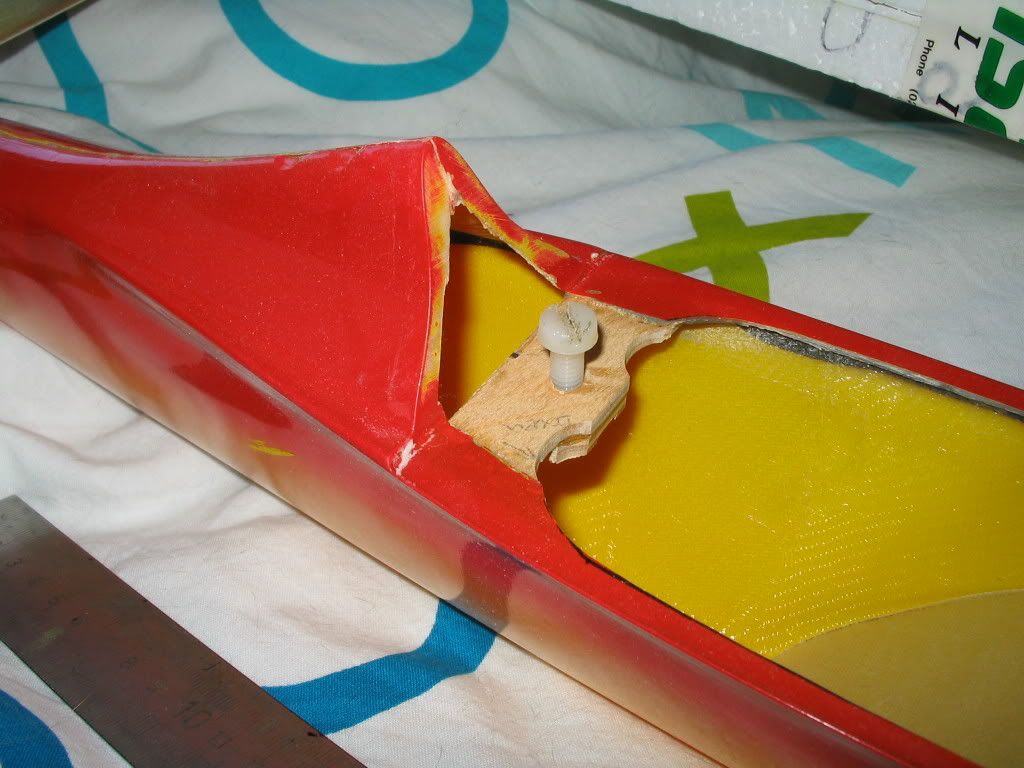
Stabilo:
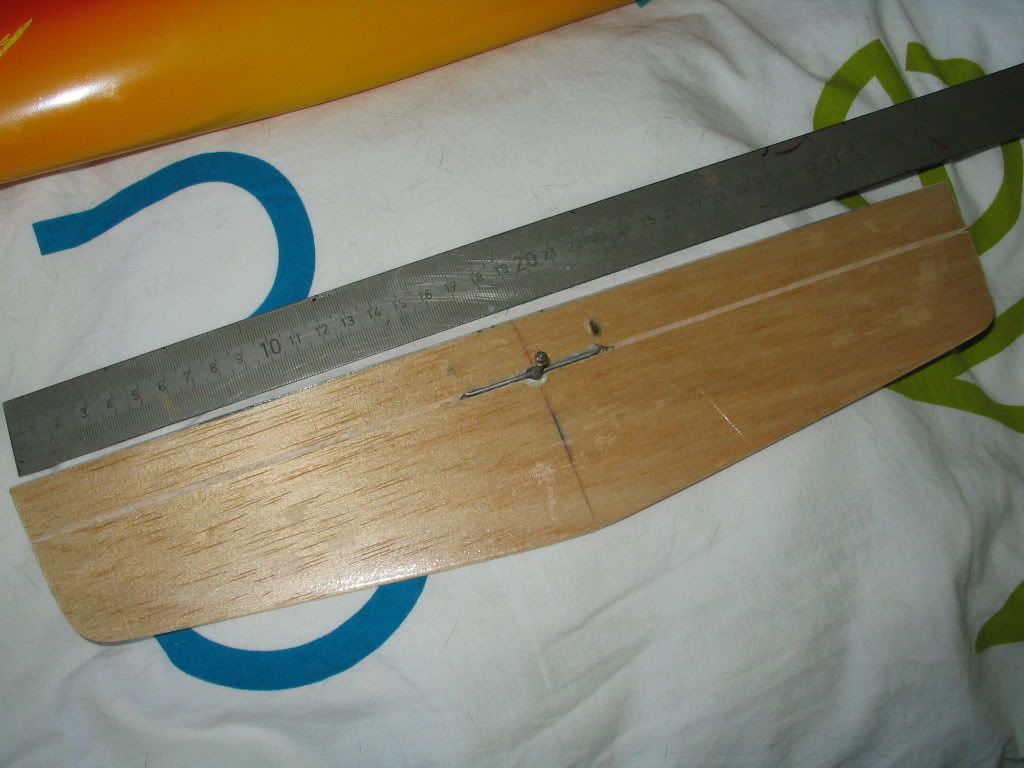

Inbouwen stabilo in romp:
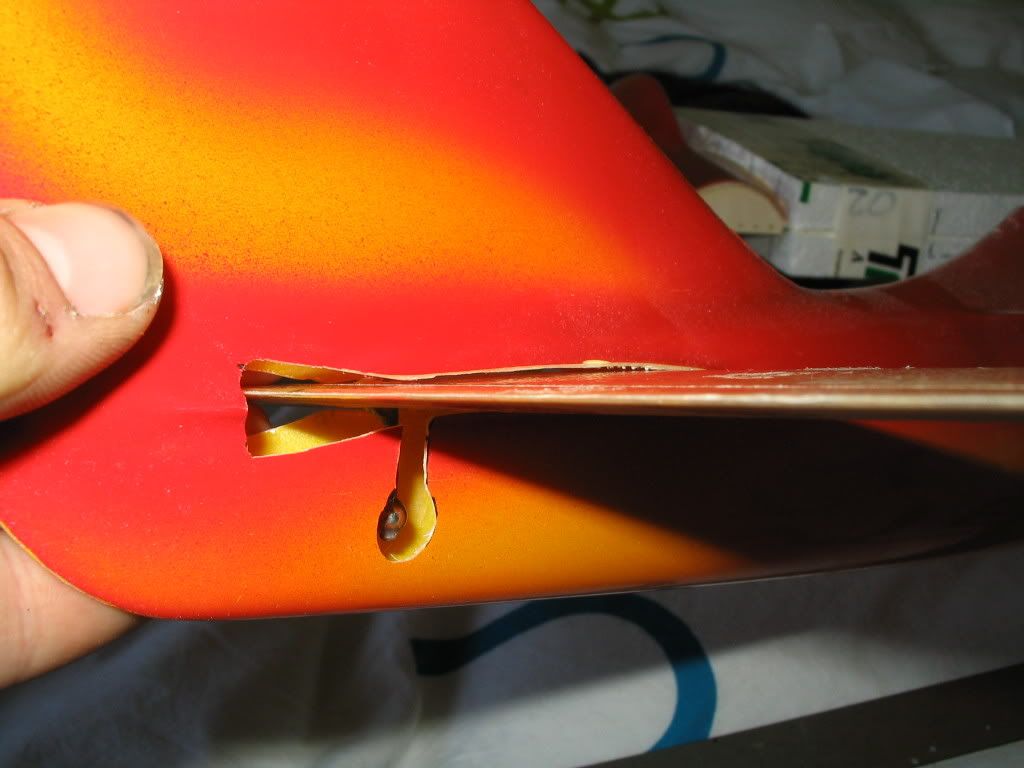
totaalplaatje:
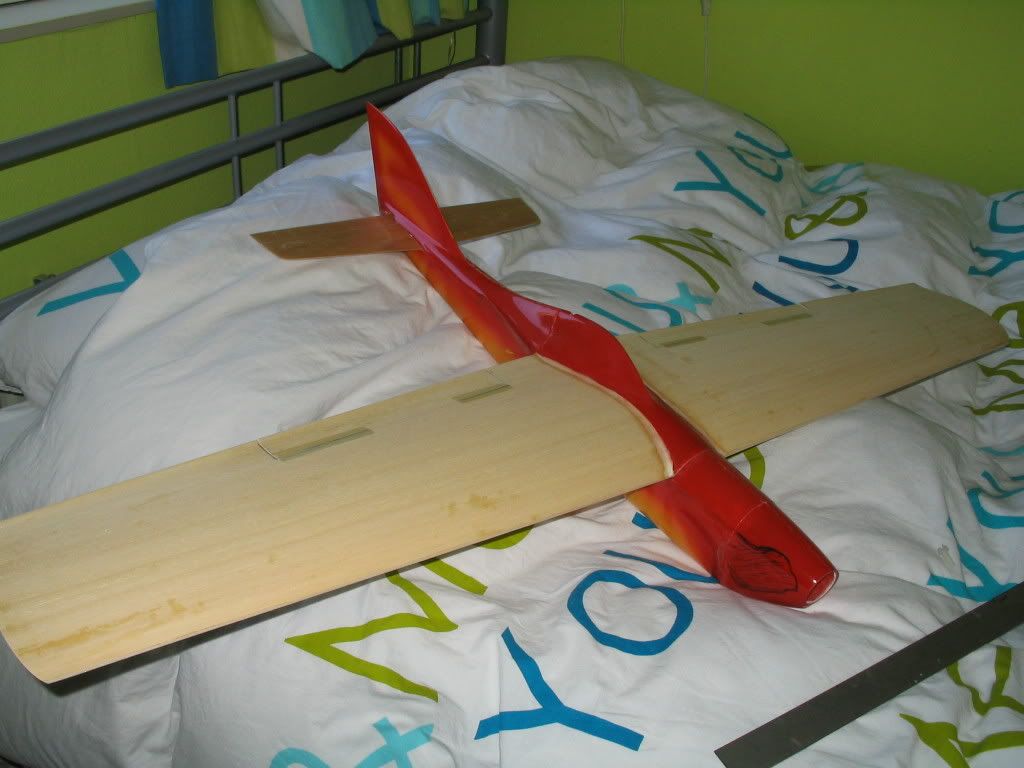
Vandaag op de club lekker wezen folieen:

En invliegen
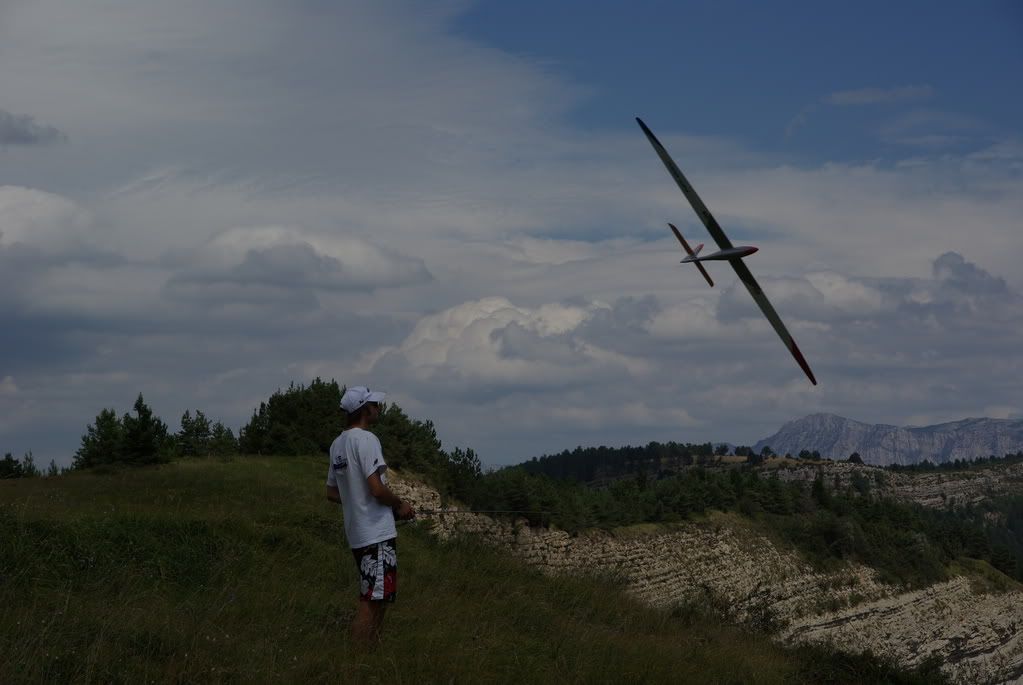
Inbouwen torsiestangen (ingegoten verenstaal met bruislijm zonder buitenkabel)

De vleugelbevesteging zonder vleugelpennen zodat je meer ruimte over houd voor de tank:


Stabilo:


Inbouwen stabilo in romp:

totaalplaatje:

Vandaag op de club lekker wezen folieen:

En invliegen

M.l.v.Doesburg
PH-SAM
Er zijn momenteel voor zo ver ik weet weer 4 nieuwe catfisches in opbouw!
Dus weer lekker racen in club 20 volgend jaar!
Dus weer lekker racen in club 20 volgend jaar!
M.l.v.Doesburg
PH-SAM
Ik denk dat ik de servo dit keer plat monteer op de vleugel. Dat geeft weer wat extra stevigheid in het middendeel aangezien ik geen glasmat heb gebruikt.